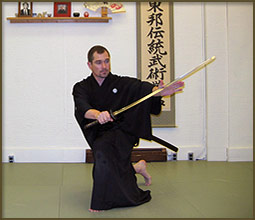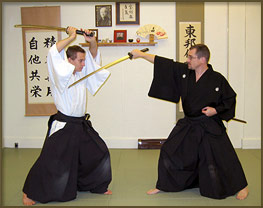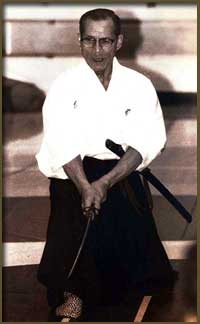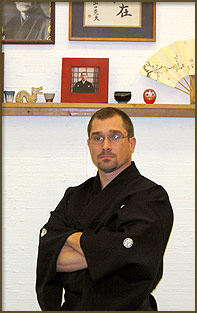|
|
Strength
 From Budo Mind and Body, by Nicklaus Suino
From Budo Mind and Body, by Nicklaus Suino
Weatherhill/Shambhala: Boston, coming March 2006.
There are three major types of strength in budo: physical strength, strength in technique, and strength of character. The power of the body is the most basic type, since it is the easiest to develop and all of us have some strength to begin with. Technique is more difficult to develop because it involves overcoming natural responses and, through training, replacing them with reasoned ones. Strength of character is the most important of these three qualities, and budo is based on the idea that the way to improve character is mainly through hard work in the other two areas.
 A long period of arduous physical training (measured in decades, not weeks) is necessary to develop mastery of technique and to affect personality. Though great masters such as Yamaoka Tesshu and Ueshiba Morihei said that a unified spirit was the single most important quality for a martial artist, both men, and many other acknowledged masters, spent thirty or forty years in extraordinarily hard physical practice before reaching that state known as "enlightenment."
A long period of arduous physical training (measured in decades, not weeks) is necessary to develop mastery of technique and to affect personality. Though great masters such as Yamaoka Tesshu and Ueshiba Morihei said that a unified spirit was the single most important quality for a martial artist, both men, and many other acknowledged masters, spent thirty or forty years in extraordinarily hard physical practice before reaching that state known as "enlightenment."
The martial artist must be physically strong because all technique is based on movement of the body. In order to persevere through the daily hours of practice, one must have endurance; to wield the sword properly, one must have strong arms; to kick well, the leg muscles must be able to easily lift the leg repeatedly into the air. Through strength training, one also develops coordination.
Strong technique is important in self-defense because we always run the risk of meeting an opponent physically stronger than ourselves. It is also important because our skills, especially those based on muscular strength, lose effectiveness as we grow older, and because we gain strength of character through the very process of studying and improving our skills. Personality and technical ability, in fact, are inseparable, and by practicing technique, we learn about ourselves. The knowledge and humility that come through lengthy practice are crucial aspects of character development.
A strong character is better than a weak one, of course. We need character because training is sometimes difficult and frustrating. We need it also because the skills we learn can make us overconfident, and because right action requires a strong will. Strength in this area is valuable, both to us and to society, because it allows us to follow through on our good intentions. The way of the martial arts is to build strength through daily practice. Start within the limits of your capabilities, gradually increasing your own demands on yourself, and practicing every day. Study those more advanced than you to find out what you need to do to improve, and read about past masters for inspiration. This method applies to each of the three areas described above.
 Physical strength can be increased in isolation, through a program of calisthenics or weight lifting, or it can be increased in conjunction with the development of technique. The way to develop them together is simply to practice each technique many times, attempting to improve gradually, while increasing the number of repetitions to fill the time available. Few students of the martial arts become experts only by attending classes, because there is not enough practice time within class hours. Most teachers utilize their class time for valuable lessons on skills and principles, and cannot include sufficient practice time, so it is the students' responsibility to seek out such time for themselves.
Physical strength can be increased in isolation, through a program of calisthenics or weight lifting, or it can be increased in conjunction with the development of technique. The way to develop them together is simply to practice each technique many times, attempting to improve gradually, while increasing the number of repetitions to fill the time available. Few students of the martial arts become experts only by attending classes, because there is not enough practice time within class hours. Most teachers utilize their class time for valuable lessons on skills and principles, and cannot include sufficient practice time, so it is the students' responsibility to seek out such time for themselves.
It is a mistake to want or to expect expertise overnight. Trying to reach too lofty a goal in a short time leads to failure, because neither the body nor the mind are prepared for the effort. In traditional martial arts, we can learn to move mountains, but we follow the methods of moving them bit by bit, in amounts we can carry safely. Developing strength of character is a natural result of correct training, but most of us need to pay special attention to right action, since not all of us were taught to choose correctly every time. In training, part of right action means admitting that some of our techniques are not as good as others, and taking the time to work on them until they improve. It also means being truthful about the results of our techniques and realizing that, although they may work in certain practice situations, they may not be as powerful as we sometimes believe they are, and thus they need ever more work. Failing to be self-critical in this way can severely limit your growth as a martial artist.
An example of this kind of failing occurs in some aikido schools, which tailor attacks to fit the defensive technique being taught. Attacks are mounted from weak or off-balance positions and attackers fall without really being thrown. Instead of practicing and refining their techniques to be effective against truly strong attacks, students learn only to ward off weak, staged attacks, and thus can never develop effective defenses. This travesty of martial arts instruction is justified by the assertion of some instructors that aikido is supposed to be harmonious, but the approach bankrupts the art of its true value as a teaching tool. It also places students in serious danger of having their skills fail them when confronted with a real self-defense situation. Real technique is technique that works, and though we try to practice safely, we must never totally remove the martial underpinnings of our arts. If a proven technique does not work for us, we must deepen our study of it until it does, rather than diluting the attack to make the technique seem successful. Teachers at these schools do not seem to realize that, though self-criticism can be uncomfortable, the very process of overcoming our weaknesses is what makes us stronger--in body, in technique, and in character.
Outside of training, we need to consciously choose to do that which is honorable, necessary, or right. When given an opportunity to cheat, we must refuse it, knowing that cheating can become a habit. When faced with an unpleasant task, we must think through to the importance of getting it done, and overcome our reluctance to complete it. The higher one rises through the ranks of martial artists, the more important this last characteristic becomes. Because the path of martial arts is so difficult, newer students often try to find ways to making it easier, and those ways include shirking their duties, blaming others for problems, and self-delusion. It falls to the senior students to correct their juniors, and almost nobody enjoys such work. Still, the necessity for doing it is clear, since a dojo would become chaotic and dangerous without good people management. The best students get the job done. By doing the necessary but unpleasant tasks, they learn about the rewards of correct action, some of which are greater control, a clearer conscience, and a better perception of truth.
There are many pitfalls on the path to becoming stronger. At the first sign of strength in themselves, many students experience an explosion of ego. They assume that since they are stronger than they once were, they are stronger than everybody, and this delusion can turn them into bullies. At the least, these students will find themselves stagnating until they can adjust their sense of themselves to fit their new abilities. At worst, they will become such bullies that they will have to be removed from the dojo.
 Inflated egos are a problem for teachers of the martial arts as well. For those in positions of leadership, many of the ordinary avenues for feedback are removed. Most students do not dare attack their teachers with their best effort, and teachers can set up practice situations to give themselves the advantage. Being the biggest fish in a small pond is rewarding, but all of us in the martial arts must remember just how large the pond really is, and how many centuries of work by previous generations of teachers went into preparing the way for us. Keeping our proper place in mind helps to keep the ego in check.
Inflated egos are a problem for teachers of the martial arts as well. For those in positions of leadership, many of the ordinary avenues for feedback are removed. Most students do not dare attack their teachers with their best effort, and teachers can set up practice situations to give themselves the advantage. Being the biggest fish in a small pond is rewarding, but all of us in the martial arts must remember just how large the pond really is, and how many centuries of work by previous generations of teachers went into preparing the way for us. Keeping our proper place in mind helps to keep the ego in check.
Those martial artists who spend enough time and sincere effort developing themselves will find that they have improved their strength in each of the three areas. It usually turns out, however, that the goal of mastery does not look quite the same from higher up the ladder as it did from the bottom rung. There is, in fact, always as much more ladder above as there is below, since strength is a relative term. One must learn to accept the fact that perfection is an elusive goal. One may work hard to overcome certain weaknesses and find that progress has been made, but also find that constant work is required to maintain those gains. New problems often arise to replace those overcome. The increased responsibility that comes with higher rank often vexes students, who find that they have to balance the problems of the dojo and its members against matters related to their own training.
Long experience in martial arts practice will show us that our only real competition is with ourselves, but some students cannot overcome the desire to compete against others. They may become strong and skilled, but find that others are still stronger and more skilled. Instead of letting this discourage them, successful martial artists will learn to use this fact to motivate themselves to continue practicing and improving. After enough years, if they practice hard, have a good teacher, and are lucky, the practitioners' techniques will improve enough that they will work even against larger and stronger opponents. This kind of success helps them see through the keyhole of the door leading to the real meaning of budo.
Because success with technique helps motivate students to further pursue good technique, they should become more effective in a range of skills over time. Ironically, however, even the goal of perfecting technique can impose barriers to progress; those who fixate on one technique or one level of difficulty will stop progressing, while those who learn to seek out new methods and continually improve themselves will continue to grow.
 Past masters have told us that, eventually, for a few of the best and most dedicated students, the pursuit of technique will become unnecessary, and they will learn to triumph using force of will. Ueshiba was said to have reached this stage near the end of his life, though he never quit practicing. Yamaoka was supposed to have been unbeatable after several decades of practice, and he attributed this to a "unity of spirit" gained though long toil.
Past masters have told us that, eventually, for a few of the best and most dedicated students, the pursuit of technique will become unnecessary, and they will learn to triumph using force of will. Ueshiba was said to have reached this stage near the end of his life, though he never quit practicing. Yamaoka was supposed to have been unbeatable after several decades of practice, and he attributed this to a "unity of spirit" gained though long toil.
These days, in fact, many claim to have come near to this state, or to have reached it. As nice as it would be to believe that many martial artists are reaching enlightenment, I personally remain skeptical. My experiences training with many of the best and most renowned masters around the world lead me to believe that even the most fantastic feats these men and women perform are still just techniques, albeit remarkably well executed, rather than "pure spirit."
What this means for the future of our own practice is twofold. First, we must be very careful about accepting claims of greatness by the people we meet, and, second, whenever we begin to think we have reached perfection ourselves, we must remember how much longer and harder other living masters have worked, and that, if they haven't liberated themselves from physical reality after all their years of work, we probably haven't either.
It is still possible, however, to believe in the possibility of greatness and the nobility of staying on the path toward it. The fantastic skills of the greatest masters are worthwhile goals in themselves, and studying to reach their level is made even more exciting by the possibility that something transcendent might lie just past our next thousand repetitions. We must constantly challenge ourselves to improve, every minute of every training day. If we honestly evaluate our strength, technique, and character, and improve each of them by small increments every day, we will sooner or later accomplish something great.
From Budo Mind and Body, by Nicklaus Suino
Weatherhill/Shambhala: Boston, coming March 2006.
|